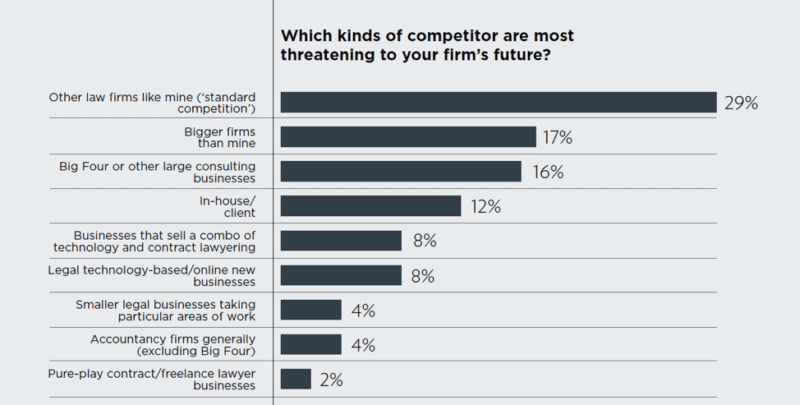The constant threat of competition is not backing down in the legal market nor outside of it. While work remains in house and alternative legal providers pose a threat, the risk is less potent than the immediate threat of another law firm. In fact, based on the recent Frontiers 2020 Legal IT landscapes, “other firms like mine” is a perceived threat to 29% of firms and an additional 17% felt the threat is coming from bigger firms than their own. Incidentally, in-house competition is seen as a threat to only 12% of firms and alternative legal providers like legal tech-based and contract lawyering account for only 8%.

The struggle for differentiation amongst firms is real
During the age of the customer, competition amongst peers is fierce, as customers seek to find the best balance between value and quality and firms seek to deliver exceptional but differentiated legal services. The type of work the client has certainly plays a role in how innovative they can be, as more commoditized work is putting pressure on firms to automate and drive efficiencies. On the flip side, more complex work is pushing firms to be more strategic and innovative in the ways they staff and serve the client. Regardless of the type of work, the bottom line is that firms are being asked to stretch themselves to accommodate the client in order to win—or in some instances even take—the work.
The overwhelming response from firms is to innovate. In an industry notoriously behind, the term innovation is a broad and deep topic, however, it leaves a lot of room for opportunity and for investment. According to the Briefing 2020 Legal IT Landscapes report, 74% of firms have an innovation budget at their firm. Given the focus on the client, it is not a surprise that 52% of firms are focused on innovation that creates client-facing products and services while another 34% are focused on creating better client service delivery through automation.
How are firms creating better client experiences and client service delivery?
Many firms are addressing this through the application of AI, machine learning and natural language process (NLP) to deliver strategic value around the client that includes collaboration, process automation, and data analytics. Near term investment in this technology includes the application of contract review (23%) and due diligence (16%) – both areas that quickly benefit from NLP and automation. These technologies aid with tasks such as identifying and enforcing outside counsel guidelines and more efficiently onboarding clients through the automation of tasks.
Nearly three quarters of the firms reported innovation budgets yet only 54% report having a dedicated leader to drive innovation. Interestingly, another quarter have named an innovation leader but with shared responsibility (i.e. also a partner or service leader elsewhere). Forty percent of respondents are in an ideal situation, reporting into the COO/partnership, as this is where strategy is typically set. The momentum of being a part of setting the strategy and including innovation can go a long way at a firm, as innovation leaders are frequently given power with very little authority. However, cultural barriers such as lawyer resistance (23%), innovation not being a priority (21%) and cost despite having a budget for it (18%) are the usual sticklers that stand in the way.

The growing importance of Knowledge Management (KM)
Something worth noting is the involvement of knowledge management (KM) on the list of departments where innovation belongs. The knowledge management role continues to grow with importance and impact, as these individuals are the keepers of the firm’s knowledge on the market, its clients and its lawyers. Given the information that is housed within knowledge management and the skills around data that are needed to support innovation efforts, it is no surprise that KMs involvement is growing. The report says it best, “there’s a lot that KM can contribute, innovation is as much about the content as it is about the IT system that manages it.”
From bringing in the right people to funding the initiatives and choosing the proper technology to support the cause, the pressure to compete in the current legal landscape is forcing firms to take a deep look within and innovate on the way they work to win and retain clients. For a majority of firms, the client is the catalyst for change and the center focus of innovation. Like most things, the devil is in the details and while mobilization is taking flight, the strategy that wins in the market is yet to be determined. We encourage you to explore these trends further and to take a closer look at the Briefing Frontiers 2020 Legal IT Landscapes to learn more.